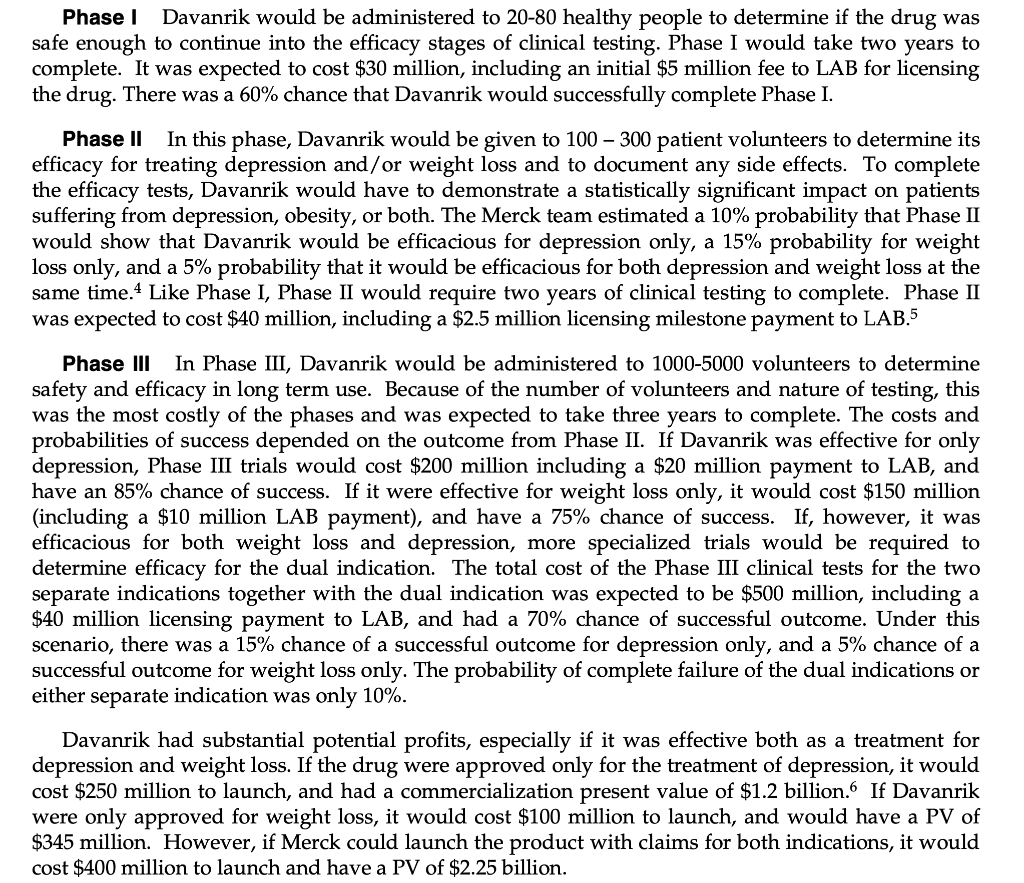Answered step by step
Verified Expert Solution
Question
1 Approved Answer
Build a decision tree that shows the cash flows and probabilities at all phases of the FDA approval process. Phasel Davanrik would be administered to

Build a decision tree that shows the cash flows and probabilities at all phases of the FDA approval process.
Phasel Davanrik would be administered to 20-80 healthy people to determine if the drug was safe enough to continue into the efficacy stages of clinical testing. Phase I would take two years to complete. It was expected to cost $30 million, including an initial $5 million fee to LAB for licensing the drug. There was a 60% chance that Davanrik would successfully complete Phase I. Phase II In this phase, Davanrik would be given to 100 300 patient volunteers to determine its efficacy for treating depression and/or weight loss and to document any side effects. To complete the efficacy tests, Davanrik would have to demonstrate a statistically significant impact on patients suffering from depression, obesity, or both. The Merck team estimated a 10% probability that Phase II would show that Davanrik would be efficacious for depression only, a 15% probability for weight loss only, and a 5% probability that it would be efficacious for both depression and weight loss at the same time. Like Phase I, Phase II would require two years of clinical testing to complete. Phase II was expected to cost $40 million, including a $2.5 million licensing milestone payment to LAB.5 Phase III In Phase III, Davanrik would be administered to 1000-5000 volunteers to determine safety and efficacy in long term use. Because of the number of volunteers and nature of testing, this was the most costly of the phases and was expected to take three years to complete. The costs and probabilities of success depended on the outcome from Phase II. If Davanrik was effective for only depression, Phase III trials would cost $200 million including a $20 million payment to LAB, and have an 85% chance of success. If it were effective for weight loss only, it would cost $150 million (including a $10 million LAB payment), and have a 75% chance of success. If, however, it was efficacious for both weight loss and depression, more specialized trials would be required to determine efficacy for the dual indication. The total cost of the Phase III clinical tests for the two separate indications together with the dual indication was expected to be $500 million, including a $40 million licensing payment to LAB, and had a 70% chance of successful outcome. Under this scenario, there was a 15% chance of a successful outcome for depression only, and a 5% chance of a successful outcome for weight loss only. The probability of complete failure of the dual indications or either separate indication was only 10%. Davanrik had substantial potential profits, especially if it was effective both as a treatment for depression and weight loss. If the drug were approved only for the treatment of depression, it would cost $250 million to launch, and had a commercialization present value of $1.2 billion. If Davanrik were only approved for weight loss, it would cost $100 million to launch, and would have a PV of $345 million. However, if Merck could launch the product with claims for both indications, it would cost $400 million to launch and have a PV of $2.25 billionStep by Step Solution
There are 3 Steps involved in it
Step: 1

Get Instant Access to Expert-Tailored Solutions
See step-by-step solutions with expert insights and AI powered tools for academic success
Step: 2

Step: 3

Ace Your Homework with AI
Get the answers you need in no time with our AI-driven, step-by-step assistance
Get Started


